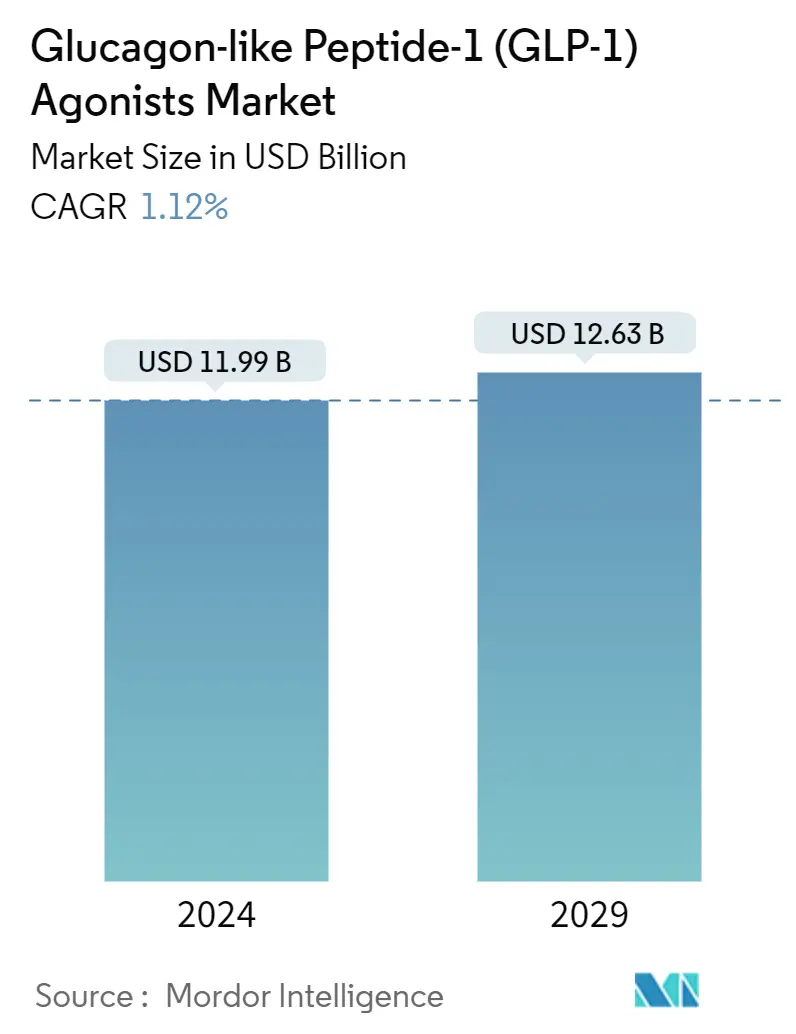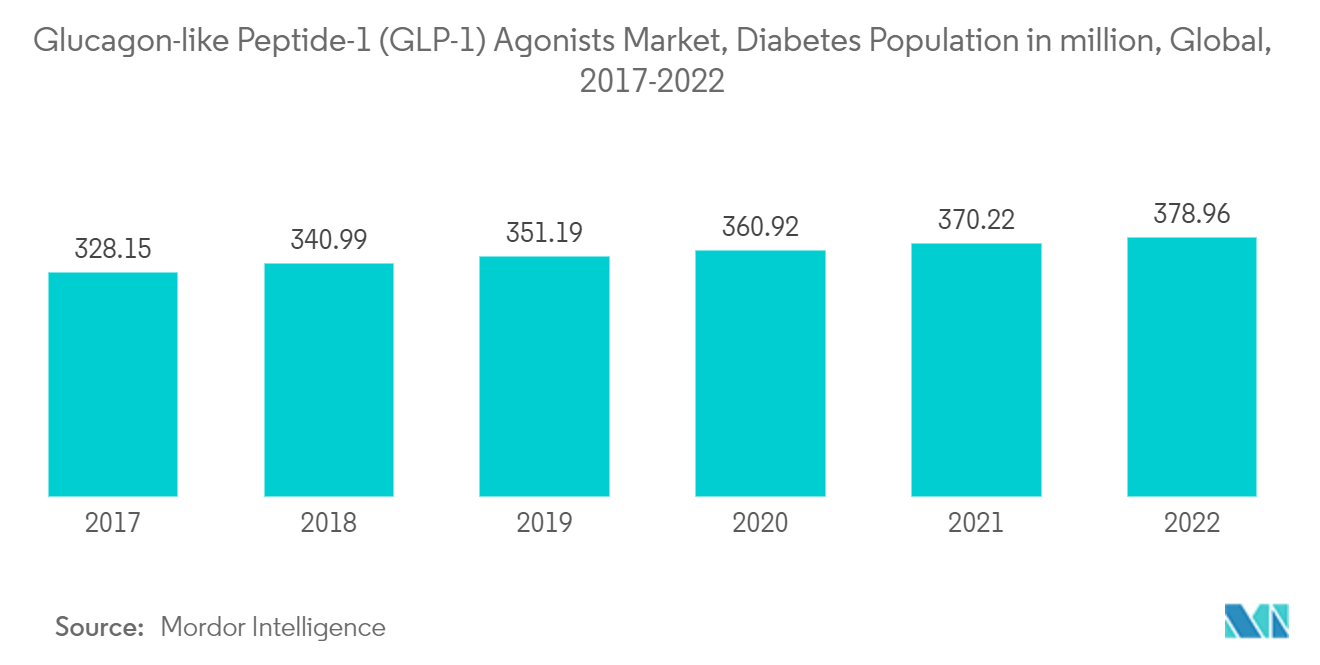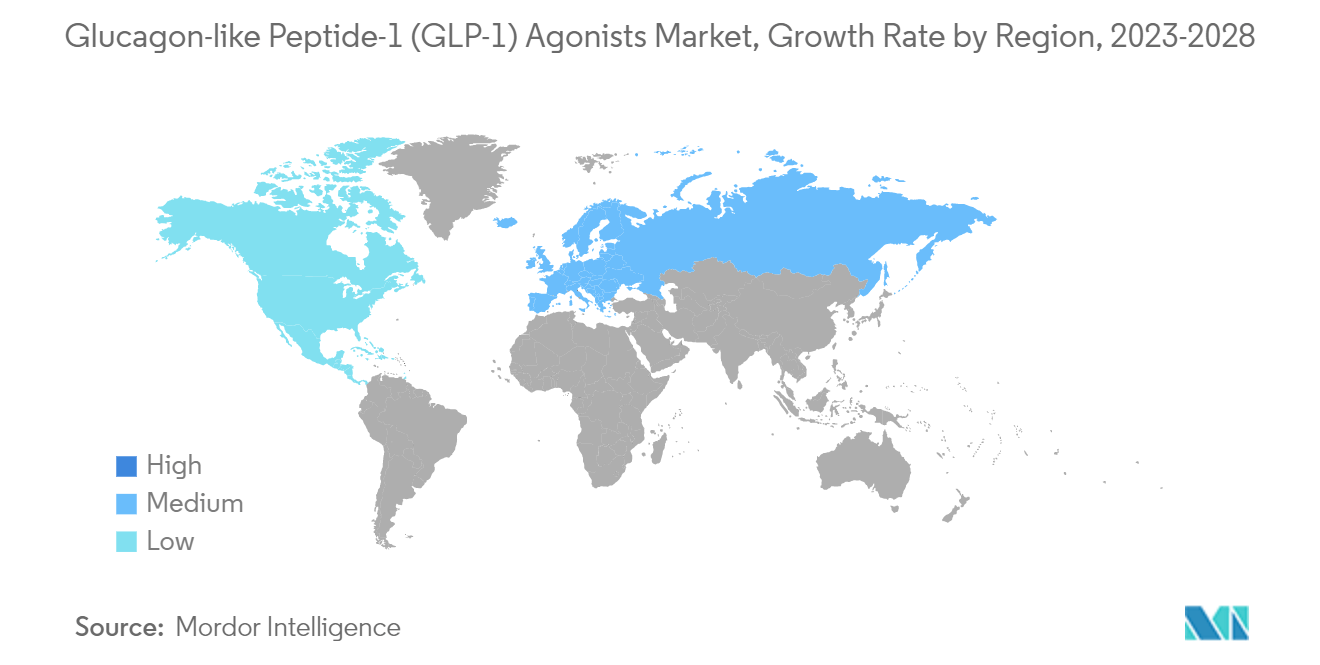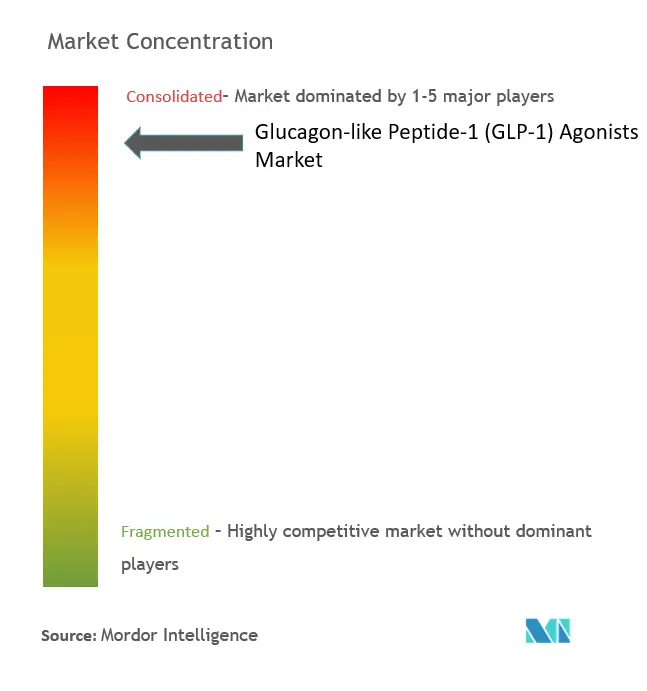Glucagon-like Peptide-1 (GLP-1) Agonists Market Size

| Study Period | 2019- 2029 |
| Market Size (2024) | USD 11.99 Billion |
| Market Size (2029) | USD 12.63 Billion |
| CAGR (2024 - 2029) | 1.12 % |
| Fastest Growing Market | Middle East and Africa |
| Largest Market | North America |
Major Players
*Disclaimer: Major Players sorted in no particular order |
Glucagon-like Peptide-1 (GLP-1) Agonists Market Analysis
The Glucagon-like Peptide-1 Agonists Market size is estimated at USD 11.99 billion in 2024, and is expected to reach USD 12.63 billion by 2029, growing at a CAGR of 1.12% during the forecast period (2024-2029).
The COVID-19 pandemic positively impacted the Glucagon-like Peptide-1 (GLP-1) Agonists Market. Diabetes and uncontrolled hyperglycemia are risk factors for poor outcomes in patients with COVID-19 including an increased risk of severe illness or death. People with diabetes have a weaker immune system, the COVID-19 complication aggravates the condition, and the immune system gets weaker very fast. People with diabetes have more chances to get into serious complications rather than normal people.
Glucagon-like peptide-1 receptor agonists (GLP-1RAs) are a class of medications used for the treatment of type 2 diabetes and some drugs are also approved for obesity. One of the benefits of this class of drugs over older insulin secretagogues, such as sulfonylureas or meglitinides, is that they have a lower risk of causing hypoglycemia. Besides being important glucose-lowering agents, GLP-1RAs have significant anti-inflammatory and pulmonary protective effects and an advantageous impact on gut microbes' composition. Therefore, GLP-1RAs have been potential candidates for treating patients affected by COVID-19 infection, with or even without type 2 diabetes, as well as excellent antidiabetic (glucose-lowering) agents during COVID-19 pandemic times.
According to International Diabetes Federation (IDF), the adult diabetes population in 2021 is approximately 537 million, and this number is going to increase by 643 million in 2030. Technological advancements have increased over the period leading to several modifications either in the GLP-1RA drug or the formulations being developed.
Therefore, owing to the aforementioned factors the studied market is anticipated to witness growth over the analysis period.
Glucagon-like Peptide-1 (GLP-1) Agonists Market Trends
Dulaglutide Segment Occupied the Highest Market Share in the Glucagon-like Peptide-1 (GLP-1) Agonists Market in the current year
Dulaglutide drug held the highest share of about 45.8% in the Glucagon-like Peptide-1 (GLP-1) Agonists Market in the current year.
GLP1RAs are available internationally and are recommended for use when treatment escalation for type 2 diabetes is required after metformin and lifestyle management. They can be safely used with all other glucose-lowering therapies except vildagliptin. Dulaglutide (Trulicity) is a weekly subcutaneous GLP1RA that reduces HbA1c with additional weight loss and cardiorenal protection benefits. Therapy with dulaglutide allows many patients to reach and maintain target HbA1c without insulin and/or sulfonylureas, eliminating the associated hypoglycemia risk. GLP1RAs elicit greater weight reduction and are recommended over SLGT2 inhibitors when cerebrovascular disease other than heart failure or renal disease predominates.
Dulaglutide is fully funded for patients meeting special authority criteria in some countries. For instance, New Zealand guidelines recommend offering GLP1RAs to all patients with HbA1c levels above target, especially when GLP1RA use would provide additional reductions in cardiovascular risk and/or permit reduction or cessation of other therapies that contribute to weight gain or hypoglycemia.
Owing to the rising rate of obesity, growing genetic factors for type-2 diabetes, and the increasing prevalence and government support initiatives, the market will likely continue to grow.

North American region held the highest market share in the Glucagon-like Peptide-1 (GLP-1) Agonists Market in the current year
North America held the highest market share of about 62.6% in the Glucagon-like Peptide-1 (GLP-1) Agonists Market in the current year.
The Centers for Disease Control and Prevention (CDC) National Diabetes Statistics Report 2022 estimated that more than 130 million adults are living with diabetes or prediabetes in the United States. Type 2 diabetes is more common, and diabetes is more consequential among communities of color, those who live in rural areas, and those with less education, lower incomes, and lower health literacy.
Health Canada is the third regulatory agency to provide more options for people interested in GLP-1 agonists. It approved the first and only GLP-1 agonist pill (Rybelsus by Novo Nordisk) for people with type 2 diabetes recently after approval by the European Medicines Agency and the US. GLP-1 RAs can be taken alone or in combination with other treatments for type 2 diabetes to improve blood glucose management, i.e., time in range. In addition to lowering blood glucose, they benefit heart health by reducing the risk of heart attack, stroke, and heart-related death. It is important because people with type 2 diabetes are at substantially higher risk of heart disease than those without diabetes.
Owing to the high prevalence of diabetes due to a sedentary lifestyle and the factors above market is expected to grow over the forecast period.

Glucagon-like Peptide-1 (GLP-1) Agonists Industry Overview
The GLP-1 market is consolidated, with major manufacturers, namely Eli Lilly, Sanofi, Novo Nordisk, AstraZeneca, etc., holding a presence in all regions.
Glucagon-like Peptide-1 (GLP-1) Agonists Market Leaders
-
AstraZeneca
-
Eli Lilly and Company
-
Sanofi
-
Novo Nordisk A/S
-
Pfizer Inc.
*Disclaimer: Major Players sorted in no particular order

Glucagon-like Peptide-1 (GLP-1) Agonists Market News
- March 2023: NHS approved Wegovy, a weight loss injection known as semaglutide. Wegovy mimics the hormone glucagon-like peptide-1 (GLP-1) and suppresses appetite. The NHS is set to offer Wegovy, a weight loss injection known as semaglutide, to thousands of people living with obesity in England.
- May 2022: The US Food and Drug Administration (FDA approved Eli Lilly and Company's Mounjaro (tirzepatide) injection as an adjunct to diet and exercise. It is to enhance glycemic control in adult patients with type 2 diabetes. A single molecule, Mounjaro is a once-weekly glucose-dependent insulinotropic polypeptide (GIP) and glucagon-like peptide-1 (GLP-1) receptor agonist.
Glucagon-like Peptide-1 (GLP-1) Agonists Market Report - Table of Contents
1. INTRODUCTION
- 1.1 Study Assumptions and Market Definition
- 1.2 Scope of the Study
2. RESEARCH METHODOLOGY
3. EXECUTIVE SUMMARY
4. MARKET DYNAMICS
- 4.1 Market Overview
- 4.2 Market Drivers
- 4.3 Market Restraints
-
4.4 Porter's Five Forces Analysis
- 4.4.1 Bargaining Power of Suppliers
- 4.4.2 Bargaining Power of Consumers
- 4.4.3 Threat of New Entrants
- 4.4.4 Threat of Substitute Products and Services
- 4.4.5 Intensity of Competitive Rivalry
5. MARKET SEGMENTATION
-
5.1 Drugs
- 5.1.1 Dulaglutide
- 5.1.1.1 Trulicity
- 5.1.2 Exenatide
- 5.1.2.1 Byetta
- 5.1.2.2 Bydureon
- 5.1.3 Liraglutide
- 5.1.3.1 Victoza
- 5.1.4 Lixisenatide
- 5.1.4.1 Lyxumia
- 5.1.5 Semaglutide
- 5.1.5.1 Ozempic
-
5.2 Geography
- 5.2.1 North America
- 5.2.1.1 United States
- 5.2.1.2 Canada
- 5.2.1.3 Rest of North America
- 5.2.2 Europe
- 5.2.2.1 Germany
- 5.2.2.2 Spain
- 5.2.2.3 Italy
- 5.2.2.4 France
- 5.2.2.5 United Kingdom
- 5.2.2.6 Russia
- 5.2.2.7 Rest of Europe
- 5.2.3 Asia-Pacific
- 5.2.3.1 Japan
- 5.2.3.2 China
- 5.2.3.3 Australia
- 5.2.3.4 India
- 5.2.3.5 South Korea
- 5.2.3.6 Malaysia
- 5.2.3.7 Indonesia
- 5.2.3.8 Thailand
- 5.2.3.9 Philippines
- 5.2.3.10 Rest of Asia-Pacific
- 5.2.4 Latin America
- 5.2.4.1 Brazil
- 5.2.4.2 Mexico
- 5.2.4.3 Rest of Latin America
- 5.2.5 Middle East and Africa
- 5.2.5.1 South Africa
- 5.2.5.2 Saudi Arabia
- 5.2.5.3 Oman
- 5.2.5.4 Egypt
- 5.2.5.5 Iran
- 5.2.5.6 Rest of Middle East and Africa
6. MARKET INDICATORS
- 6.1 Type-1 Diabetes Population
- 6.2 Type-2 Diabetes Population
7. COMPETITIVE LANDSCAPE
-
7.1 COMPANY PROFILES
- 7.1.1 Novo Nordisk
- 7.1.2 Sanofi
- 7.1.3 Eli Lilly
- 7.1.4 AstraZeneca
- 7.1.5 Boehringer Ingelheim
- 7.1.6 Pfizer
- *List Not Exhaustive
-
7.2 MARKET SHARE ANALYSIS
- 7.2.1 NovoNordisk
- 7.2.2 Sanofi
- 7.2.3 AstraZeneca
- 7.2.4 Others
8. MARKET OPPORTUNITIES AND FUTURE TRENDS
** Subject To AvailablityGlucagon-like Peptide-1 (GLP-1) Agonists Industry Segmentation
GLP-1 receptor agonists are a non-insulin medication combined with diet and exercise to help treat type 2 diabetes. The Glucagon-like Peptide-1 (GLP-1) Agonists Market is segmented into drugs (Dulaglutide(Trulicity), Exenatide (Byetta and Bydureon), Liraglutide (Victoza), Lixisenatide (Lyxumia), and Semaglutide (Ozempic)), and Geography (North America, Europe, Asia-Pacific, Middle East and Africa, and Latin America). The report offers the value (in USD) and volume (in units) for the above segments. Further, the report will cover a segment-wise breakdown (value and volume) for all the countries covered under the Table of Contents.
| Drugs | Dulaglutide | Trulicity |
| Drugs | Exenatide | Byetta |
| Bydureon | ||
| Drugs | Liraglutide | Victoza |
| Drugs | Lixisenatide | Lyxumia |
| Drugs | Semaglutide | Ozempic |
| Geography | North America | United States |
| Canada | ||
| Rest of North America | ||
| Geography | Europe | Germany |
| Spain | ||
| Italy | ||
| France | ||
| United Kingdom | ||
| Russia | ||
| Rest of Europe | ||
| Geography | Asia-Pacific | Japan |
| China | ||
| Australia | ||
| India | ||
| South Korea | ||
| Malaysia | ||
| Indonesia | ||
| Thailand | ||
| Philippines | ||
| Rest of Asia-Pacific | ||
| Geography | Latin America | Brazil |
| Mexico | ||
| Rest of Latin America | ||
| Geography | Middle East and Africa | South Africa |
| Saudi Arabia | ||
| Oman | ||
| Egypt | ||
| Iran | ||
| Rest of Middle East and Africa |
Glucagon-like Peptide-1 (GLP-1) Agonists Market Research FAQs
How big is the Glucagon-like Peptide-1 Agonists Market?
The Glucagon-like Peptide-1 Agonists Market size is expected to reach USD 11.99 billion in 2024 and grow at a CAGR of 1.12% to reach USD 12.63 billion by 2029.
What is the current Glucagon-like Peptide-1 Agonists Market size?
In 2024, the Glucagon-like Peptide-1 Agonists Market size is expected to reach USD 11.99 billion.
Who are the key players in Glucagon-like Peptide-1 Agonists Market?
AstraZeneca, Eli Lilly and Company, Sanofi, Novo Nordisk A/S and Pfizer Inc. are the major companies operating in the Glucagon-like Peptide-1 Agonists Market.
Which is the fastest growing region in Glucagon-like Peptide-1 Agonists Market?
Middle East and Africa is estimated to grow at the highest CAGR over the forecast period (2024-2029).
Which region has the biggest share in Glucagon-like Peptide-1 Agonists Market?
In 2024, the North America accounts for the largest market share in Glucagon-like Peptide-1 Agonists Market.
What years does this Glucagon-like Peptide-1 Agonists Market cover, and what was the market size in 2023?
In 2023, the Glucagon-like Peptide-1 Agonists Market size was estimated at USD 11.86 billion. The report covers the Glucagon-like Peptide-1 Agonists Market historical market size for years: 2019, 2020, 2021, 2022 and 2023. The report also forecasts the Glucagon-like Peptide-1 Agonists Market size for years: 2024, 2025, 2026, 2027, 2028 and 2029.
What are the key factors driving the growth of the GLP-1 Agonist Market?
The key factors driving the growth of the GLP-1 Agonist Market are a) Rising diabetes prevalence b) Growing obesity concerns c) Expanding treatment options
GLP-1 Agonists Industry Report
The global GLP-1 agonists market is witnessing remarkable growth, driven by the increasing prevalence of type 2 diabetes and obesity. These medications are essential for glucose regulation, mimicking the endogenous hormone GLP-1's action. Their effectiveness in managing blood sugar levels, providing cardiovascular benefits, and aiding weight loss makes them a preferred treatment for type 2 diabetes. The market, detailed by Mordor Intelligence™, is segmented by drugs, brands, administration routes, and end-users, ranging from hospitals to specialty clinics.
The exploration of GLP-1 agonists for non-diabetic uses, such as obesity and non-alcoholic fatty liver disease, is expanding the market. Despite high costs and concerns over injection-based administration, the development of oral formulations is expected to boost patient adherence. Influenced by technological advancements and a focus on comprehensive diabetes management, the GLP-1 agonists market is at the forefront of diabetes care, promising enhanced patient outcomes globally.
The market size and market share of GLP-1 agonists are crucial metrics for understanding their impact. Market analysis and market research provide insights into the market trends and market growth, which are essential for industry reports. Industry analysis and industry research offer a comprehensive view of the industry outlook and industry trends. The market forecast and market outlook help predict future market value and market segmentation.
Industry information, industry reports, and industry statistics are vital for understanding industry sales and industry size. Market data and market review offer detailed insights into market leaders and market predictions. Research companies use report examples and report PDFs to provide detailed market analysis.
In conclusion, the GLP-1 agonists market is characterized by significant growth rate and market value, driven by advancements in diabetes care and expanding applications. The market segmentation and market trends highlight the importance of these medications in managing diabetes and related conditions. The industry outlook remains positive, with continuous innovations and increasing adoption of GLP-1 agonists globally.



